Cite this document
(Motivation and Leadership at GE Case Study Example | Topics and Well Written Essays - 2750 words, n.d.)
Motivation and Leadership at GE Case Study Example | Topics and Well Written Essays - 2750 words. https://studentshare.org/management/1706728-management-research-paper
Motivation and Leadership at GE Case Study Example | Topics and Well Written Essays - 2750 words. https://studentshare.org/management/1706728-management-research-paper
(Motivation and Leadership at GE Case Study Example | Topics and Well Written Essays - 2750 Words)
Motivation and Leadership at GE Case Study Example | Topics and Well Written Essays - 2750 Words. https://studentshare.org/management/1706728-management-research-paper.
Motivation and Leadership at GE Case Study Example | Topics and Well Written Essays - 2750 Words. https://studentshare.org/management/1706728-management-research-paper.
“Motivation and Leadership at GE Case Study Example | Topics and Well Written Essays - 2750 Words”. https://studentshare.org/management/1706728-management-research-paper.


